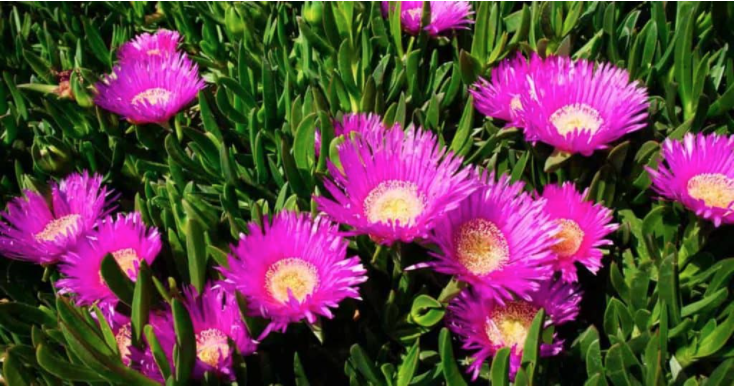
Ice Plant is native to South Africa.
Natives in northwest United States had a saying: When the tide is out the table is set. I use a variation in my foraging classes: Food is where the water is. Foraging is treasure hunting for adults. An unusual edible we saw this weekend in Port Charlotte was Carpobrotus edulis, the ice plant. It was in a neighborhood near Bayshore Park on Sibley Bay Street. My only other sighting of this species was a few years ago on the land side of Fred Howard Park, Tarpon Springs. You can also find it at the Nature Park in Punta Gorda. Ice Plant resembles purslane on steroids. Definitely not native, it’s a succulent-looking ground cover often put into coastal landscape. Leaves are less than two-inches long, opposite, evergreen, lance shaped. The plant gets to about a foot high and is drought tolerant. The pink blossom with a yellow center is cactus-like. Leaves are used in salads. Fruits are eaten raw, dried, cooked or pickled or used in chutneys and preserves. Also edible are C. aequilaterus and C. deliciosus.
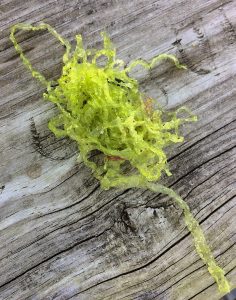
Enteromorpha some times called Ulva. Photo by Green Deane
The tide was quite low at Port Charlotte so we got to see some sea lettuce, Ulva lactuca, (bottom right) looking like green plastic wrap. Sold commercially it’s one of the more tasty local sea weeds (or as they are called now sea vegetables.) Sea Lettuce is more commonly found after a steady onshore sea breeze. Free floating it starts out attached to a shell or rock. If you find lots of a sea lettuce-like plant but it’s stringy, not wrapper-like, that is the Enteromorpha version (photo left). The second thing you might notice about the Enterophrphas besides looking stringy is they are a similar bright light green as the Ulva. Some taxonomists have given up and call them all Ulva or all Enteromorpha. Enteromorpha in Dead Latin mangled from Greek literally means intestine-shaped, Ulva means sedge in Dead Latine or wolf in Gaelic (sometimes a girl’s name.) Both groups are also called Green Nori. What is native, what is not, and what are their ranges is officially “unclear.” They can also be found inland at salty springs and also the Great Lakes. As far as I know all Ulva and Enterophorpha are edible. The various Enteromorpha species are E. intestinalis, E. clathrata, E. flexuosa, E. compressa, E. linza, and E. prolifera. Like Ulva, they are edible raw, cooked or preserved. In fact a restaurant at Port Canaveral used to see a Sea Lettuce salad.
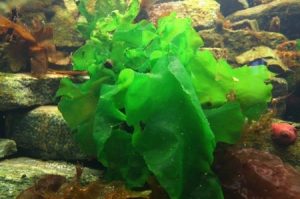
Sea Lettuce is perhaps the best of our local seaweeds.
Since most seaweed is edible, and nutritious, why isn’t it consumed more often? Taste and texture. I’ve collected Sargassum and prepared it many ways. Semi-drying and frying isn’t too bad but Bladderwrack is better, Sea Lettuce better still. Sea Lettuce is about the best in the Americas. Not surprisingly most land animals including birds don’t like seaweed. However, it does make good mulch and fertilizer. So while one may not use it directly in the diet it can still help sustain you with uses in the garden. During Victorian times it was highly used in English agriculture. Here are some of my articles on seaweed: Bladderwrack, Caulpera, Codium, Gracilaria, Sargassum, Sea Lettuce, and Tape Seagrass.
Foragers benefit from bad ideas. One of those is taking plants from one place on earth to another. We harvest and eat a lot of local plants that came from somewhere else. One of them is so far from home that it fruits in February.
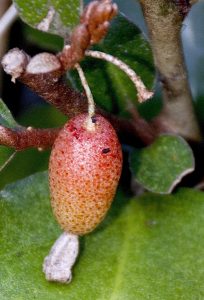
Silverthorn berries are ripening now.
The Silverthorn is native to Southeast Asia. It came to North America as an ornamental about 200 years ago. Early botanists were sure it would not become an invasive pest because they said the fruit were not nutritious for birds. Thus, the birds would not eat them and spread the seeds around. The problem is no one told the birds that (and if birds did not spread the seeds around in Asia, what did?) In some areas the Silverthorn is an invasive species and forbidden. In other areas it is still sold as an ornamental. We call it tasty and we has some almost ripe ones Sunday in Sarasota.
Silverthorn fruits ripen about Valentine’s Day, give or take a week or two. The bush hides the blossoms and they are a bit strange looking, if not futuristic. The four-petaled speckled blossom turns into a red jelly bean-like fruit with gold and silver speckles. They are bitter and or sour until ripe. The shelled seed is also edible. Altogether the fruit is high in vitamin C, lycopene, and Omega 3 fatty acids. And that is a tasty treat in the middle of winter even up into north Georgia. To read more about the Silverthorn go here.
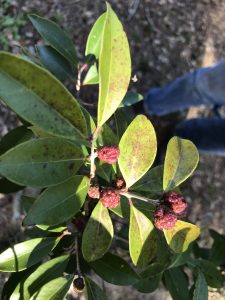
Unidentified shrub with what appears fruit turned into galls. Photo by Green Deane
There are at the least two ways to look at plants: As a whole comprising of parts, or, parts that comprise a whole. This is not a riddle or a paradox. Beginners tend to see whole plants not their parts and experienced foragers tend to see parts that either do or do not make the whole. Beginners will make such mistakes as identifying Florida Pursley for Chickweed because they have a similar shape even though they are very different in size and hairiness. Similar confusion happen with Oakleaf Flea Bane and Plantagos — both have stem threads — Elderberries and Water Hemlock because of similar leaves and blossoms and environment preference. Experience foragers see a whole comprised of parts and it all works or it does not. If a plant were a jigsaw puzzle beginners see the general shape and notice there is a picture. Experience folks see the pieces, the picture in detail and the shape that then make a whole. When you’re used to looking at plants it can sometimes look right but something is naggingly wrong (usually one of the parts, so always be sensitive to that little doubt.) This shrub to th right — still unidentified by me — resembles a Marlberry but… the arrangement and low amount of fruit is wrong (according to Marlberries I have seen.) And the taste of the black fruit was surprisingly palatable whereas marlberries are usually barely edible. The whole of the shrub is suggests Marlberry, the parts do not. Also the fruit seems to become galled and the seed disappears. So it’s still on the “I don’t know list” though it is nursery-raised and I would thus presume probably a native as it was intentionally planted in a park. I’d suggest a Foresteria but it’s fruit is bitter and this is sweet. In foraging “close” is not good enough.

Classes are held rain or shine (but not during hurricanes.)
Foraging Classes: Classes this week are in Winter Park, north of Orlando, and John Chestnut Park, not far from Tarpon Springs
Saturday February 5th, Mead Garden: 1500 S. Denning Dr., Winter Park, FL 32789. Meet at the bathrooms. 9 a.m. to noon.
Sunday February 6th, John Chestnut County Park: 2200 East Lake Road, Palm Harbor, FL 34685. Meet at the trail head of the Peggy Park Nature Walk, pavilion 1 parking lot. 9 a.m. to noon.
Saturday February 12th, Spruce Creek Park, 6250 Ridgewood Ave. Port Orange, 9 a.m. to noon, meet at the pavilion.
Sunday February 13th, Eagle Park Lake, 1800 Keene Road, Largo, FL 33771. 9 a.m. to noon. Meet at the pavilion near the dog park.
Saturday February 19th, Dreher Park, 1200 Southern Blvd., West Palm Beach, 33405. 9 a.m. to noon, meet just north of the science center.
Sunday February 20th, Blanchard Park, 10501 Jay Blanchard Trail, Orlando, FL 32817. 9 a.m. to noon. Meet at the pavilion next to (east of) the tennis courts.
Saturday February 26th, Tide Views Preserve, 1 Begonia Street, Atlantic Beach Fl 32233 (near Jacksonville Fl.) 9 a.m. to noon. Meet at the parking lot.
Sunday February 27th, Mead Garden: 1500 S. Denning Dr., Winter Park, FL 32789. Meet at the bathrooms. 9 a.m. to noon.
Saturday/Sunday May 7th & 8th, Honea Path, South Carolina, classes at 9 a.m. and 1 p.m. each day.
For more information, to pre-pay or sign up go here
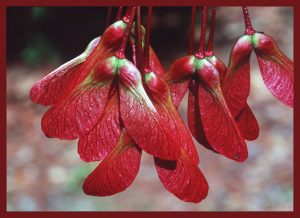 If you look across local lakes now you will see garnet red splotches on the horizon. Those are maples putting on new leaves. Are maple leaves edible? Yes and seeds, too. Are they prime foraging food? Opinions vary. The delicate samaras (see right) happen to be red but they can also be green. Later the auto-rotating wings will turn brown. Locally the trees are so heavy with seeds they appear red from a distance. As for eating them what you need to do is taste them first. If they are not bitter you can tear off the wings and eat them raw though some folks eat the soft wings as well. If they are bitter they need to be cooked in boiling water, cooled, then tasted. They should be less bitter. You may have to boil them again. Non-bitter seeds can also be roasted or sun-dried. Some Native Americans sprouted the seeds for a treat. I do not know of any toxic maple seeds to humans but red maple (Acer rubrum) leaves and seeds are toxic to horses. That said I do recall we had two red maple intentionally planted in the barnyard. My step-father liked the looks of them. Our horses — definitely leaves eaters — left them alone. To read more about maples go here.
If you look across local lakes now you will see garnet red splotches on the horizon. Those are maples putting on new leaves. Are maple leaves edible? Yes and seeds, too. Are they prime foraging food? Opinions vary. The delicate samaras (see right) happen to be red but they can also be green. Later the auto-rotating wings will turn brown. Locally the trees are so heavy with seeds they appear red from a distance. As for eating them what you need to do is taste them first. If they are not bitter you can tear off the wings and eat them raw though some folks eat the soft wings as well. If they are bitter they need to be cooked in boiling water, cooled, then tasted. They should be less bitter. You may have to boil them again. Non-bitter seeds can also be roasted or sun-dried. Some Native Americans sprouted the seeds for a treat. I do not know of any toxic maple seeds to humans but red maple (Acer rubrum) leaves and seeds are toxic to horses. That said I do recall we had two red maple intentionally planted in the barnyard. My step-father liked the looks of them. Our horses — definitely leaves eaters — left them alone. To read more about maples go here.

Green Deane videos are now available on a USB.
My nine-DVD set of 135 videos has been phased out and replaced by a 171-video USB. The USB videos are the same videos I have on You Tube. Some people like to have their own copy. The USB videos have to be copied to your computer to play. If you want to order the USB go to the DVD/USB order button on the top right of this page or click here. That will take you to an order form. Or you can make a $99 donation, which tells me it is for the USB (include a snail-mail address.) I’d like to thank all of you who ordered the DVD set over the years which required me to burn over 5,000 DVDs individually. I had to stop making them as few programs now will read the ISO files to copy them.

Green Deane Forum
Want to identify a plant? Perhaps you’re looking for a foraging reference? You might have a UFO, an Unidentified Flowering Object, you want identified. On the Green Deane Forum we — including Green Deane and others from around the world — chat about foraging all year. And it’s not just about warm-weather plants or just North American flora. Many nations share common weeds so there’s a lot to talk about, such as the one to the left. There’s also more than weeds. The reference section has information for foraging around the world. There are also articles on food preservation, and forgotten skills from making bows to fermenting food. Recent topics include: California Wild Mushroom Parties, A Good Reason To Eat Wild Garlic, Black Walnuts and Amaranth, Sea Salt and Plastic, Wild Mustard? Heavy Metals. Oriental Persimmons. What is it? Pine Cough Drops and Needles, Skullcap, Malodorous Plant? Another NJ Tree, Maypop? Roadside Plant, Unknown in Sudan, Please Help Identify, and Preserving Prickly Pear Bounty. You can join the forum by clicking on the button on the upper right hand side of this page.
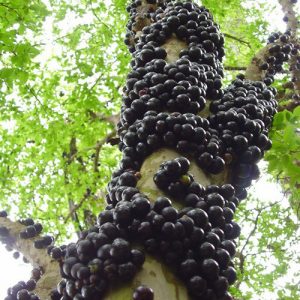
Jabuticaba fruit grows on the trunk and limbs of the tree.
In its native Brazil the Jabuticaba is by far the most popular fruit. The Dutch knew about it in 1658. Jabuticaba made it to California by 1904. It’s a common ornamental and there are many “cultivars:” Sabara, Paulista, Rajada, Branca, Ponhema, Rujada, Roxa, Sao Paulo, Coroa, Murta, and Mineira. Per 100 grams Plinia cauliflora fruit has 45.7 calories, 0.11 grams of protein, 0.08 grams of fiber, 0.01 grams of fat and 12.58 gams of carbohydrates. Vitamin A is absent but it has 22.7 mg of vitamin C which is about a third of your daily need. The B vitamins are B1 (thiamin) 0.02 mg, B2 (riboflavin) 0;02 mg, and B3 (niacin) 0.21 mg. Two minerals are reported: Calcium 6.3 mg and phosphorus 9.2 mg. It is also called Myrciaria cauliflora.
It’s a short tree planted in warm areas of North American and a common ornamental in Florida and the Gulf Coast. One is reported to sustain an 18F freeze and continued to thrive and fruit. Jabuticaba means “like turtle fat” referring to the fruit pulp, or, it means “tortoise place.” Take your pick. Myrciaria is from the Greek myrike (μυρίκη) which was the Greek name for the “tamarisk” a tree that is aromatic. In English it becomes Myrtle. Cauliflora means cauliflower-like. Plinia is Dead Latin for filled, full, rich, whole, perfect, well-equipped. You might remember from history Pliny the Elder and Younger.
This is my weekly newsletter #493. If you want to subscribe to this free newsletter you can find the sign-up form in the menu at the top of the page. My website, EatTheWeeds.com, which is data secure, has over 1500 plants on it in some 428 articles. I wrote every one myself, no cut and paste.
To donate to the Green Deane Newsletter click here.


The jabuticaba is one of the best fruit in the world. I encountered it on one of three business trips to Brazil.
I have one tree here at the house. It is still small. A slow grower, it takes many years to produce even one fruit. I’m still waiting.
Bok Tower Garden, Lake Wales, Florida, has two or three in their kitchen garden. They were flowering a few weeks ago.
I like Bok Tower (I once wrote an article on their carillon for Piano Magazine. Their price of admission has gone up considerably.